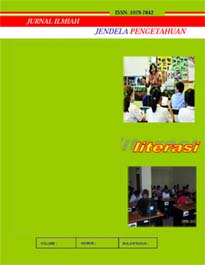The Role of Geography in Urban Spatial Planning
Peran Geografi dalam Penataan Ruang Perkotaan
Abstract
The rapid and complex development of cities has impacted various aspects of people's lives, including environmental, social, economic, and political issues. Therefore, spatial planning is essential in maintaining sustainable urban development. Geography is crucial in determining optimal spatial patterns, identifying and analyzing urban area issues, and providing solutions and recommendations to overcome them. In spatial planning, geography also utilizes GIS (Geographic Information System) technology to map and analyze spatial data visually, which can assist in decision-making and more effective and efficient development planning. In this regard, the role of geography is critical to understanding and identifying these issues and providing appropriate and sustainable solutions. In conclusion, geography has a significant role in urban spatial planning. It can assist in determining optimal spatial patterns, identifying and analyzing urban area issues, and providing appropriate and sustainable solutions and recommendations..
Downloads
References
Acuto, M. (2015). Implosions/explosions. Towards a study of planetary urbanization, edited by Neil Brenner. Taylor & Francis.
Graham, S., & Marvin, S. (2001). Splintering urbanism: Networked infrastructures, technological mobilities and the urban condition. Routledge.
Harvey, D. (2012). Rebel cities: From the right to the city to the urban revolution. Verso Books.
Lasaiba, M. A. (2013). Kajian Keruangan Penggunaan Lahan Dalam Pengembangan Kota Ambon Berbasis Ekologi. Jurnal Pendidikan Geografi UNESA, 11(21), 34–56.
Lasaiba, M. A. (2016). Dimensi Spasial Karakteristik Sebaran Dan Deviasi Pola Pegunungan Lahan Terhadap Ekosistem Pesisir Di Kota Ambon. Jendela Pengetahuan, 9(1), 24–34.
Lasaiba, M. A. (2018). Penggunaan Model Pembelajaran Berbasis Masalah (Problem Based Learning) Terhadap Hasil Belajar Geografi Pada Peserta Didik Kelas Vii-2 Smp Negeri 14 Ambon. Jendela Pengetahuan, 11(2), 8–21. https://ojs3.unpatti.ac.id/index.php/jp/article/view/6317
Lefebvre, H. (1991). The production of space. Blackwell.
Nurcholis, M., & Suwondo, D. (2021). Dampak kebijakan penataan ruang terhadap ketersediaan lahan di kawasan urban: Studi kasus di kota Semarang. Jurnal Geografi Lingkungan, 5(1), 40-51.
Sassen, S. (2011). Cities in a world economy (sociology for a new century series). Sage publications.
Soja, E. W. (2010). Seeking spatial justice (Vol. 1). U of Minnesota Press.
Smith, N. (1996). The new urban frontier: Gentrification and the revanchist city. Psychology press.
Steven, P., & Paul, K. (2000). Urban social geography: an introduction. Pearson Education Limited, England, 20106th.
Zhou, G., Zhang, J., Li, C., & Liu, Y. (2022). Spatial Pattern of Functional Urban Land Conversion and Expansion under Rapid Urbanization: A Case Study of Changchun, China. Land, 11(1). https://doi.org/10.3390/land11010119
















